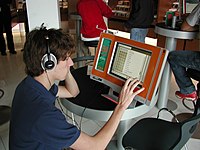
Photo from wikipedia
Abstract Based on measurements of VHF radiation sources and VLF electric fields with a broadband interferometer system, the spatial evolution of leader processes and K-breakdowns and M-components involved in a… Click to show full abstract
Abstract Based on measurements of VHF radiation sources and VLF electric fields with a broadband interferometer system, the spatial evolution of leader processes and K-breakdowns and M-components involved in a classically-triggered negative lightning discharge have been analyzed. While a normal classically-triggered negative discharge usually starts with a positive leader initiates from the tip of the ascending triggering-wire and moves upward, there was no such an initial upward positive leader (UPL) being observed for the present discharge, probably due to low resolution and sensitivity of the measurements. Instead, there was a downward negative leader (PDL) at the preliminary stage of the discharge being observed, followed by a 173-ms-long lasting M-component-wise process and two leader/return-stroke processes. The PDL was most likely a leader process along the channel trace possibly built by the undetected UPL, as its speed which ranged from 3.7 × 10 6 m/s to 0.3 × 10 6 m/s is similar to that of a dart leader in literature. The long lasting M-component-wise process consisted of a slow negative-going change stage (Ma), followed by a fast negative-going change stage (Mb) and then a slow positive-going change stage (Mc). Ma was found to be intra-cloud negative breakdowns moving towards overhead position of the PDL trace. Mb would be considered as a common M-component (channel brightening), which starts with a K breakdown in cloud (Mb1) moving horizontally towards overhead position of the previous PDL, followed by an event (Mb2) moving up from ground to cloud along PDL trace. As Mb2 reaching the cloud, more new K breakdowns (Mc) appeared in cloud around extremities of the pre-built channels by Ma and Mb. The leader preceding the first return stroke (L1) started inside the cloud and propagated downward to the triggering-wire trace, but with a different channel to that of PDL. As the leader touched the triggering wire trace, it appeared to propagate upward along the same channel of PDL. The upward portion of L1 might be interpreted as a reflection of L1 at top of the triggering-wire trace towards the PDL trace due to the difference in conductivity and potential between the PDL trace, the triggering wire trace and the L1 channel, which was optically invisible but bright in VHF. The speed of the downward portion of L1 decreased from 2.32 to 0.32 × 10 6 m/s as it descended, while that of the upward portion of L1 increased from 0.85 to 2.7 × 10 6 m/s as it ascended. The leader preceding the second return stroke (L2) behaved similarly to L1 but with higher speeds.
Journal Title: Journal of Atmospheric and Solar-Terrestrial Physics
Year Published: 2017
Link to full text (if available)
Share on Social Media: Sign Up to like & get
recommendations!